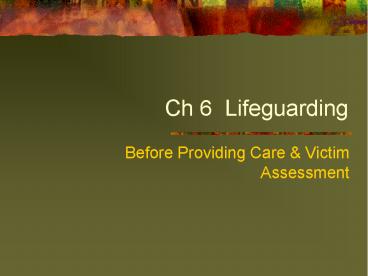Ch 6 Lifeguarding - PowerPoint PPT Presentation
Title:
Ch 6 Lifeguarding
Description:
Ch 6 Lifeguarding Before Providing Care & Victim Assessment – PowerPoint PPT presentation
Number of Views:78
Avg rating:3.0/5.0
Title: Ch 6 Lifeguarding
1
Ch 6 Lifeguarding
- Before Providing Care Victim Assessment
2
Blood Borne Pathogens
- Are bacteria and viruses present in blood and
body fluids, which cause disease to humans. - Bacteria can live outside the body
- Viruses are in the body and difficult to kill
- Are spread through direct or indirect contact
- The primary concern for professional rescuers are
hepatitis B, hepatitis C and HIV
3
Direct contact
- Kissing
- Touching
- Sex
4
Indirect contact
- Coming in contact with something that has been
touched by droplets of an infected person - Sneeze
- Cough
5
Bacteria
- Can be treated with antibiotics
- Strep throat
- Gonorrhea
- Anthrax
- Lyme disease
6
Viruses
- Few medications can fight viruses
- The bodys immune system is number one protection
against infection - Influenza
- Chickenpox
- Ebola
7
Viruses Continued
- Herpes
- Hepatitis
- HIV/AIDS
8
Herpes
- A highly contagious STD that is caused by two
forms of herpes simplexes - Simplex 1-fever blisters/ cold sores in the mouth
or lips - Simplex 2-blister-like lesions in the genital
areas
9
Hepatitis B
- Is a liver infection
- Can be severe or fatal
- Sign and symptoms jaundice, fatigue, joint pain,
nausea, loss of appetite - There is currently a vaccine (3 doses)
10
Hepatitis C
- Liver disease
- Most common chronic bloodborne infection in the
US - Signs symptoms jaundice, dark urine, abdominal
pain, loss of appetite, nausea - There is no vaccination and no treatment after
exposure
11
HIV
- This virus causes AIDS
- Destroys the immune system
- Signs symptoms many
- No cure or vaccination
12
Fact About AIDS
- The disease
- AIDS- Acquired Immune Deficiency Syndrome
- Caused by HIV
- Human Immunodeficiency Virus
13
Famous People Affected/ Died From HIV/AIDS
- Arthur Ashe
- Rock Hudson
- Liberache
- Freddy Mercury
- Magic Johnson
14
How is the Disease Transmitted?
- The virus enters three basic ways
- Through direct contact with the blood stream
(blood, semen, vaginal fluids, breast milk) - Through the mucous membrane linings (eyes, mouth,
throat, rectum, vagina) - Mother to unborn baby
15
Prevention
- Your behavior can put you at risk for being
infected with HIV, HBV/HCV - Sharing needles
- Unprotected sex
16
First Aid Precautions
- Make sure immunizations are up to date
- Avoid touching body fluids
- Wear disposable gloves dispose of properly
- Wash hands before and after care
- Clean areas that come in contact with body fluids
(water/bleach solution)
17
Precautions continued
- Use a pocket mask when giving mouth-to-mouth
resuscitation - Dont eat, drink, or touch your mouth, nose, or
eyes when giving care - Be prepared by having first aid kit handy
stocked with protective equipment supplies
18
Pocket Masks
19
Removing Latex Gloves
20
Skill AssessmentGlove Removal
21
General Procedures for Injury or Sudden Illness
on Land
- 1. Size up the scene
- Is scene safe?
- Look for dangers (down power lines, traffic,
explosions, etc) - Put on protective equipment
- What happened?
- of victims
- Additional help needed? (fire, police, EMS)
22
General Procedures cont
- 2. Perform Initial Assessment
- Is done to identify life-threatening conditions
23
How to perform initial assessment
- CHECK the victim for consciousness obtain
CONSENT if victim is conscious - Tap on shoulder, askare you ok? Pinch an infants
toe - IF NO RESPONSESummon EMS
- CHECK for signs of life (movement and breathing)
- Look, listen, feel
- CHECK for a pulse
- Carotid artery in neck (adult/child)
- Brachial artery inside arm/bicep (infant)
- CHECK severe bleeding
24
General Procedures cont
- Summon EMS
- 9-1-1
- Give conditions
- Perform Secondary Assessment
- Identifies additional conditions
- May become life threatening if not cared for
25
Demonstrate Practice Performing Initial
Assessment
- Pages 95-96
26
Demonstrate Practice Emergency Moves (pp.
98-100)
- Two-person seat carry
- Walking assist
- Pack-strap carry































